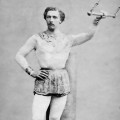The Trapeze
The world's first trapeze performance took place in Paris on November 12, 1859. On that date at the Cirque Napoleon, Jules Léotard amazed the audience by swinging through the air on his new invention. The trapeze has been a staple of circus performances ever since.
Circus Circuit I've never been much for conventional circuses—maybe clown humor is too sophisticated for me, or maybe I sense that those trained animals could be doing something more natural than balancing on giant balls or jumping through hoops. But I've never failed to be impressed by Cirque du Soleil, whose shows are mainly about highlighting human strength, skill, and artistic ability—along with wonderful music and costumes. The first time I saw their show “Mystère” in Las Vegas, I thought it was the most amazing performance I'd ever witnessed. When they added a second permanent show, “O,” just a few doors down the Strip, I started wondering how many Cirque du Soleil shows one city could possibly support before reaching the saturation point. Now I know the answer: at least five (but the city keeps growing, so you never know).
But I digress. One of the attractions that keeps people going to the circus—and enables Cirque du Soleil to expand its empire endlessly—is a deceptively simple apparatus known as the trapeze: a horizontal bar hanging from a pair of ropes or cables. Before Jules Léotard came up with this idea, circus performers sometimes walked tightropes and swung from fixed bars. Merely becoming a human pendulum, of course, is not the interesting part—it's doing things like jumping from one swinging bar to another in midair, with maybe a couple of somersaults in between. The whole notion of jumping, falling, or flying freely through the air high above the ground is what terrifies and delights audiences.
The Trend Setter That 1859 debut trapeze performance, on a rig with three trapezes, lasted 12 minutes and featured the first midair trapeze somersault. Léotard, whose father, Jean, was a gymnastics instructor, invented not only the trapeze apparatus and technique, but also the garment typically worn while performing on it: the eponymous leotard. Although it is sensible enough not to wear loose or restrictive clothing while performing acrobatics high above the ground, Léotard was apparently just as interested in showing off his muscular physique. Léotard himself called the garment a maillot, the word that would later come to mean “swimsuit” in French. In retrospect, this was an apt term: although there was no safety net during the performance, Léotard had developed his act while practicing on trapezes suspended over a swimming pool.
Léotard was the inspiration for the song “The Flying Trapeze,” written by George Leybourne in 1868. Although I've seen at least half a dozen different versions of the lyrics, the chorus goes approximately like this: He'd fly through the air with the greatest of ease, That daring young man on the flying trapeze. His movements were graceful, all girls he could please And my love he purloined away.
I do not know if Léotard, in his skin-tight costume, did in fact purloin anyone's love away, but if so, the romance was brief. Two years after the song was written, in 1870, Léotard died while visiting Spain—not from trapeze-related injuries, but apparently from smallpox. The year of Léotard's birth is a matter of some dispute (I've seen claims ranging from 1838 to 1842), but in any case he was around 30 when he died. Had he lived another year, he would have seen the first safety nets installed under trapeze rigs, which emboldened future performers to attempt flashier and riskier moves.

